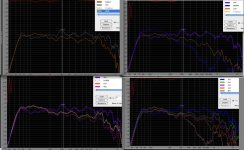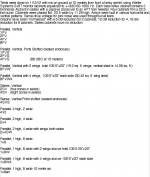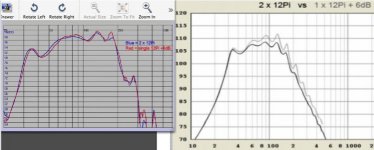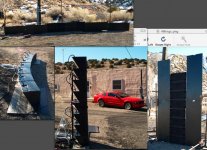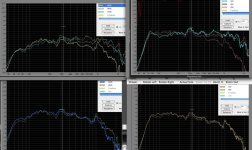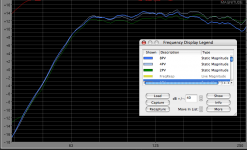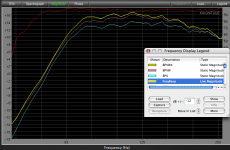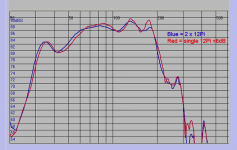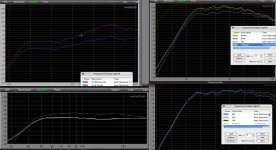After noting differences between measured results of single cabinets of various types (TH, FLH, and BR) compared to multiple cabinet simulations using Hornresp, I conducted an extensive series of outdoor tests using one through eight bass reflex (BR) cabinets in various arrays.
Coherent summation of multiple cabinets should yield a 6 dB addition per doubling, +3 dB for doubling radiation area, and +3 dB for doubling power.
The closest to coherent summation was achieved with the speakers placed in an arc with all cabinets ten meters from the measurement mic, resulting in a net even response between one and 8 cabinets from F3 to around 250 Hz.
Incoherent summation results in only an average +3 dB addition per doubling of power and cabinets.
The graphs have been “normalized” with a 6 dB reduction for 2 cabinets, 12 dB reduction for 4, 18 dB reduction for 8 cabinets so that differences from coherent summation can be seen. Series cabinets have no normalization, as the net result of less power per cabinet and increased radiation net a 0 dB change.
The results of the tests show how different arrays result in quite different upper response from single units. Although David McBean is considering some changes to Hornresp, they still will not be able to reflect each type of array response, a complicated combination of many factors beyond the present model.
Similar upper frequency response reduction and general smoothing as is seen and heard in FLH and TH response occurs in the BR cabinets also.
The frontal area of the stack makes a significant difference in response shape, adding “wings”, flat pieces of plywood (AKA “barn doors”) to the stacks add 2 to 3 dB to the LF response when the frontal area is tripled.
Art Welter
Coherent summation of multiple cabinets should yield a 6 dB addition per doubling, +3 dB for doubling radiation area, and +3 dB for doubling power.
The closest to coherent summation was achieved with the speakers placed in an arc with all cabinets ten meters from the measurement mic, resulting in a net even response between one and 8 cabinets from F3 to around 250 Hz.
Incoherent summation results in only an average +3 dB addition per doubling of power and cabinets.
The graphs have been “normalized” with a 6 dB reduction for 2 cabinets, 12 dB reduction for 4, 18 dB reduction for 8 cabinets so that differences from coherent summation can be seen. Series cabinets have no normalization, as the net result of less power per cabinet and increased radiation net a 0 dB change.
The results of the tests show how different arrays result in quite different upper response from single units. Although David McBean is considering some changes to Hornresp, they still will not be able to reflect each type of array response, a complicated combination of many factors beyond the present model.
Similar upper frequency response reduction and general smoothing as is seen and heard in FLH and TH response occurs in the BR cabinets also.
The frontal area of the stack makes a significant difference in response shape, adding “wings”, flat pieces of plywood (AKA “barn doors”) to the stacks add 2 to 3 dB to the LF response when the frontal area is tripled.
Art Welter
Attachments
I like the "barn doors"
So when I build my tapped horn--would adding barn doors to it give me about 2 to 3 extra dB also? If the horn is tuned for 18Hz, would it be advisable to use heavy bracing--say pieces of 2x2 lumber to frame the doors?
I'm always interested in "free dBs" and the barn doors would help when dragging the speakers outside for BBQs and such.
So when I build my tapped horn--would adding barn doors to it give me about 2 to 3 extra dB also? If the horn is tuned for 18Hz, would it be advisable to use heavy bracing--say pieces of 2x2 lumber to frame the doors?
I'm always interested in "free dBs" and the barn doors would help when dragging the speakers outside for BBQs and such.
The results of the tests show how different arrays result in quite different upper response from single units. Although David McBean is considering some changes to Hornresp, they still will not be able to reflect each type of array response, a complicated combination of many factors beyond the present model.
Hi Art,
Many thanks for taking the time and effort to conduct these very comprehensive tests.
Your measurements now make it quite clear to me that unfortunately, I am probably wasting my time trying to develop a new multiple speakers model that will ultimately be any better overall, than the current one. There are just too many variables to take into account.
In the circumstances, perhaps a more sensible approach may be to simply keep the current model, but to document known limitations in the Hornresp Help file so that users are aware of the shortcomings.
A couple of comments on speaker testing in general, in relation to Hornresp:
Hornresp assumes that the outputs from multiple speakers are in effect combined into one "concentrated" sound source. This means that to most accurately reflect the simulation assumption, four speakers should ideally be configured in a 2 x 2 square array - rather than a 1 x 4 linear array, for example. Eight speakers should be configured in a 3 x 3 array, but with only two speakers in the top row, centrally positioned. Not sure how much of a difference, if any, this would actually make to measured results though
Tests should ideally be done under anechoic conditions, meaning that to replicate 2 x Pi half space conditions outdoors, it would be necessary to place the speakers on solid ground, pointing vertically towards the sky with the microphone suspended an appropriate distance above the geometric centre of the array, suitably shielded from the wind. Not a very practical proposition in your case
Thanks again for all your assistance - it is greatly appreciated!
Kind regards,
David
An other intested PDF from LinearX about arrays sum in LEAP : http://www.linearx.com/files/pdf/EncShopApp_02.pdf
Getting an extra 2 to 3 dB down to 18Hz would probably require much larger "barn doors" than what I have used, the extenders used on my TH and FLH provide an increase in level down to about 35 Hz.So when I build my tapped horn--would adding barn doors to it give me about 2 to 3 extra dB also? If the horn is tuned for 18Hz, would it be advisable to use heavy bracing--say pieces of 2x2 lumber to frame the doors?
If the panels are vibrating much, some acoustical energy is being wasted.
That said, flopping panels will loose more energy in the upper bass range than lower.
My panels have a 1.5" x 2" brace on the mouth side, that seems adequate to keep them from flexing.
Thank you Art,
So if triple-wide is good to 35Hz--that is good enough for outside use for BBQs. Since I've done some DIY stuff, there is a dedicated pile of wood for bracing so I'll give it a shot.
Once I finish my line array mod, I'll have spare wood to make some doors to attempt to get the most bass I can out of 24 five inch woofers. Ironically, I'll have enough wood and 24 feet of 2x2's to make one and check it out. If it's ugly, it has to work!
So if triple-wide is good to 35Hz--that is good enough for outside use for BBQs. Since I've done some DIY stuff, there is a dedicated pile of wood for bracing so I'll give it a shot.
Once I finish my line array mod, I'll have spare wood to make some doors to attempt to get the most bass I can out of 24 five inch woofers. Ironically, I'll have enough wood and 24 feet of 2x2's to make one and check it out. If it's ugly, it has to work!
Last edited:
Documenting known limitations in the Hornresp Help file so that users are aware of the shortcomings would be a good solution.Hi Art,
Your measurements now make it quite clear to me that unfortunately, I am probably wasting my time trying to develop a new multiple speakers model that will ultimately be any better overall, than the current one. There are just too many variables to take into account.
In the circumstances, perhaps a more sensible approach may be to simply keep the current model, but to document known limitations in the Hornresp Help file so that users are aware of the shortcomings.
A couple of comments on speaker testing in general, in relation to Hornresp:
Hornresp assumes that the outputs from multiple speakers are in effect combined into one "concentrated" sound source. This means that to most accurately reflect the simulation assumption, four speakers should ideally be configured in a 2 x 2 square array - rather than a 1 x 4 linear array, for example. Eight speakers should be configured in a 3 x 3 array, but with only two speakers in the top row, centrally positioned. Not sure how much of a difference, if any, this would actually make to measured results though.
Kind regards,
David
It is worth noting that the ground plane reflection made the 2x4 and 4x2 stacks both fairly equal, and 1-2 dB louder in the LF than the vertical or horizontal line of eight cabinets.
The addition of the wings adds a bit more level down low than I would have expected on BR cabinets, almost as much as the 3 dB they did when added as a 90 degree "waveguide" to TH or FLH horns.
Art
... If the horn is tuned for 18Hz, would it be advisable to use heavy bracing--say pieces of 2x2 lumber to frame the doors?...
I'd imagine you'd have to have an effective baffle width/height of ~60ft to eliminate 4PI transition at 18hz.... uh.... I think?
I'd imagine you'd have to have an effective baffle width/height of ~60ft to eliminate 4PI transition at 18hz.... uh.... I think?
I have about 20 feet of garage wall, figured I could use it to give a boost down to a usable level if I do it right. Inside the garage I have plywood walls with corner loading--outside I lose that advantage.
Since I have 4 x 8 sheets of plywood, I'll screw around with putting them on either side of the line arrays to hear if it would increase the bass level enough so a subwoofer is not necessary--much easier for BBQs that way.
An other intested PDF from LinearX about arrays sum in LEAP : http://www.linearx.com/files/pdf/EncShopApp_02.pdf
Hi sebDIY,
Thanks for this reference. I found the following statement interesting:
"However, simulation of each array required 3 hours of CPU time and consumed over 500MB of memory. Large arrays can exhaust the entire 2GB address space of the Win32 operating system."
No wonder Hornresp is having trouble coming to terms with multiple speaker arrays...
Kind regards,
David
Documenting known limitations in the Hornresp Help file so that users are aware of the shortcomings would be a good solution.
Hi Art,
Would something like the following be sufficient, or should more information be included? Thanks.
Multiple Speakers
~~~~~~~~~~~
Displays the far-field SPL response of a given multiple loudspeaker array connected to a single amplifier. The results are normalised to a distance of one metre. Not applicable to infinite horns.
For multiple tapped horns and vented speaker systems, the bass extension and downward movement of the lower rolloff corner frequency are likely to be less than predicted.
Kind regards,
David
David,Hi Art,
Would something like the following be sufficient, or should more information be included? Thanks.
Multiple Speakers
~~~~~~~~~~~
Displays the far-field SPL response of a given multiple loudspeaker array connected to a single amplifier. The results are normalised to a distance of one metre. Not applicable to infinite horns.
For multiple tapped horns and vented speaker systems, the bass extension and downward movement of the lower rolloff corner frequency are likely to be less than predicted.
That explanation would be helpful, you could also add a " single amplifier capable of constant voltage into any impedance", as most real world amplifiers are not capable of that.
Another helpful addition would be:
A large array becomes an additional boundary which increases forward directivity, which imparts low frequency gain in addition to the 6 dB of doubling radiation area and power.
Cabinets with large frontal area compared to the horn exit or driver and port area may exhibit additional low frequency gain in addition to the 6 dB of doubling radiation area and power.
That said, looking at the response of BR, FLH, and TH in the passband normally associated with “subs”, 20 Hz to 200 Hz, it appears to me that a 6 dB gain per cabinet doubling across the frequency range describes the behavior of the array, with the above statements added, and perhaps mention upper frequency incoherence due to a wide array width at relatively close measurement distance.
Art
Attachments
David,
That explanation would be helpful, you could also add a " single amplifier capable of constant voltage into any impedance", as most real world amplifiers are not capable of that.
Another helpful addition would be:
A large array becomes an additional boundary which increases forward directivity, which imparts low frequency gain in addition to the 6 dB of doubling radiation area and power.
Cabinets with large frontal area compared to the horn exit or driver and port area may exhibit additional low frequency gain in addition to the 6 dB of doubling radiation area and power.
That said, looking at the response of BR, FLH, and TH in the passband normally associated with “subs”, 20 Hz to 200 Hz, it appears to me that a 6 dB gain per cabinet doubling across the frequency range describes the behavior of the array, with the above statements added, and perhaps mention upper frequency incoherence due to a wide array width at relatively close measurement distance.
Art
Hi Art,
Many thanks for your comments. After giving it some further thought, I have decided not to make any appreciable changes to the Multiple Speakers tool description. The original aim of the Help File was to document all the features available in Hornresp as concisely as possible. To include the additional things now being discussed would move away from this "minimalist" philosophy - something I would prefer not to do.
Kind regards,
David
David,Hi Art,
Many thanks for your comments. After giving it some further thought, I have decided not to make any appreciable changes to the Multiple Speakers tool description. The original aim of the Help File was to document all the features available in Hornresp as concisely as possible. To include the additional things now being discussed would move away from this "minimalist" philosophy - something I would prefer not to do.
Kind regards,
David
I agree, including information that would explain why measured results won’t match the Hornresp multiple cabinet response simulation would not be "minimalist"
Art
A full transfer from half space to 1/4 space would theoretically add 6 dB, it is interesting that a relatively small area can add 3 dB of gain down to the Fb or Fc of a speaker system, and a dB or so below Fb and Fc.I'd imagine you'd have to have an effective baffle width/height of ~60ft to eliminate 4PI transition at 18hz.... uh.... I think?
It is possible that the baffle size I used, less area than a 4'x 8' sheet of plywood, may actually add +3 dB of forward gain down to an 18Hz Fb.
The lower left graph below is a pair of FLH with and without the same “barn doors” as used in a TH test (upper left) and the BR test (upper right), though the barn doors are at a 90 degree angle for the horns and a 180 degree angle for the BR.
Attachments
I agree, including information that would explain why measured results won’t match the Hornresp multiple cabinet response simulation would not be "minimalist".
Hi Art,
True
I guess part of the problem for me is that I can't really explain in definitive or absolute terms why the results should be so different. One obvious contributor of course, as previously stated, is that Hornresp calculates power response whereas the measurements show pressure response. There will always be differences between the two at higher frequencies because of the complex and often unpredictable nature of the directivity effects associated with loudspeaker arrays. There also seems to be some question as to how much mutual coupling can be expected with different speaker types - the coupling of multiple direct radiators seems to be rather different to that of bass horns, for example. You have already noted the differences in the low frequency performance of multiple tapped horns, bass-reflex speakers and front-loaded horns.
A rigorous multiple speakers model would need to take things like directivity, mutual impedances, array configuration, diffraction, mouth geometry, etc, into account - even then, the predictions would not necessarily be entirely accurate. Hornresp simply attempts to simulate the power response of an array configured as a concentrated source.
Despite the known shortcomings, from a theoretical viewpoint there is certain consistency about the current Hornresp multiple speakers models that is reasonably reassuring - intuitively it makes sense, to me at least
To illustrate - the following three systems will all generate the same SPL response in Hornresp:
1. A single horn speaker radiating into 2 Pi half space.
2. A single horn speaker with two drivers connected in parallel and cross-sectional areas doubled, radiating into 4 Pi free space.
3. Two horn speakers connected in parallel radiating into 4 Pi free space.
Kind regards,
David
Actually, the measured “ mutual coupling” of multiple BR,TH, and FLH cabinets of similar frontal dimensions are remarkably similar, with the exception of a very slight decrease in the F3 point with multiple FLH.I guess part of the problem for me is that I can't really explain in definitive or absolute terms why the results should be so different. One obvious contributor of course, as previously stated, is that Hornresp calculates power response whereas the measurements show pressure response. There will always be differences between the two at higher frequencies because of the complex and often unpredictable nature of the directivity effects associated with loudspeaker arrays. There also seems to be some question as to how much mutual coupling can be expected with different speaker types - the coupling of multiple direct radiators seems to be rather different to that of bass horns, for example. You have already noted the differences in the low frequency performance of multiple tapped horns, bass-reflex speakers and front-loaded horns.
A rigorous multiple speakers model would need to take things like directivity, mutual impedances, array configuration, diffraction, mouth geometry, etc, into account - even then, the predictions would not necessarily be entirely accurate. Hornresp simply attempts to simulate the power response of an array configured as a concentrated source.
Despite the known shortcomings, from a theoretical viewpoint there is certain consistency about the current Hornresp multiple speakers models that is reasonably reassuring - intuitively it makes sense, to me at least.
To illustrate - the following three systems will all generate the same SPL response in Hornresp:
Additional gain over the predicted +6 dB for each doubling can be accounted by the directionality a large frontal boundary affords.
Frequency response smoothing in multiples of all types are evident, though slightly less evident in BR or sealed front loaded speakers.
“Hornresp calculates power response whereas the measurements show pressure response”.
That statement goes a long ways in explaining measured differences in upper response, don’t recall you pointing that out before.
It may be quite obvious to you, but was not obvious to me, (Hornresp charts are labled SPL Response in dB ) I had not understood that a program called Hornresp would not consider one of the most useful features a horn provides, directivity.
A constant directivity horn such as provided with a simple conical expansion does not change in power response above the frequency where it exhibits constant directivity, regardless of boundaries, as the horn walls already define the boundary.
The “intuitively reasonably reassuring” system models, which ignore (don’t account for) directivity allow Hornresp to show highly inflated upper frequency levels when changing from whole space to 1/8th space compared to measured results.
Thanks for pointing out the many reasons behind measured differences and Hornresp simulations.
Art
Hi Art,
See my post #1267 in the 'Single sheet TH challenge' thread, dated 5th January 2012.
http://www.diyaudio.com/forums/subwoofers/170771-single-sheet-th-challenge-127.html#post2847389
It's explained in the Help file:
QUOTE
SPL Response
~~~~~~~~
Sound pressure produced at a point source normalised distance of one metre when the driver is supplied with a signal of a given voltage, versus frequency in hertz. The level is expressed in decibels relative to the standard reference sound pressure of 20 micropascals.
The default response assumes constant directivity. The constant directivity SPL response is also the acoustical power response.
The Directivity Response tool can be used to take into account the frequency dependent directional characteristics of finite single-segment horns.
UNQUOTE
The Hornresp chart you refer to is titled 'SPL Response (dB) - Constant Directivity'. It predicts the sound pressure level or SPL, assuming constant directivity, as explained in the Help file.
Hornresp has directivity tools.
Are you referring to a single speaker or a multiple speaker array? The levels for a single speaker would be even higher if directivity was taken into account, due to beaming at upper frequencies concentrating more of the sound energy on axis. If you are measuring pressure levels less than those predicted by Hornresp at upper frequencies, then it can only mean that your measurements are not being conducted in a true eighth-space environment.
Kind regards,
David
“Hornresp calculates power response whereas the measurements show pressure response”.
That statement goes a long ways in explaining measured differences in upper response, don’t recall you pointing that out before.
See my post #1267 in the 'Single sheet TH challenge' thread, dated 5th January 2012.
http://www.diyaudio.com/forums/subwoofers/170771-single-sheet-th-challenge-127.html#post2847389
It may be quite obvious to you, but was not obvious to me,
It's explained in the Help file:
QUOTE
SPL Response
~~~~~~~~
Sound pressure produced at a point source normalised distance of one metre when the driver is supplied with a signal of a given voltage, versus frequency in hertz. The level is expressed in decibels relative to the standard reference sound pressure of 20 micropascals.
The default response assumes constant directivity. The constant directivity SPL response is also the acoustical power response.
The Directivity Response tool can be used to take into account the frequency dependent directional characteristics of finite single-segment horns.
UNQUOTE
(Hornresp charts are labled SPL Response in dB)
The Hornresp chart you refer to is titled 'SPL Response (dB) - Constant Directivity'. It predicts the sound pressure level or SPL, assuming constant directivity, as explained in the Help file.
I had not understood that a program called Hornresp would not consider one of the most useful features a horn provides, directivity.
Hornresp has directivity tools.
The “intuitively reasonably reassuring” system models, which ignore (don’t account for) directivity allow Hornresp to show highly inflated upper frequency levels when changing from whole space to 1/8th space compared to measured results.
Are you referring to a single speaker or a multiple speaker array? The levels for a single speaker would be even higher if directivity was taken into account, due to beaming at upper frequencies concentrating more of the sound energy on axis. If you are measuring pressure levels less than those predicted by Hornresp at upper frequencies, then it can only mean that your measurements are not being conducted in a true eighth-space environment.
Kind regards,
David
David,Hi Art,
The default response assumes constant directivity. The constant directivity SPL response is also the acoustical power response.
The Directivity Response tool can be used to take into account the frequency dependent directional characteristics of finite single-segment horns.
The Hornresp chart you refer to is titled 'SPL Response (dB) - Constant Directivity'. It predicts the sound pressure level or SPL, assuming constant directivity, as explained in the Help file.
Hornresp has directivity tools.
Are you referring to a single speaker or a multiple speaker array? The levels for a single speaker would be even higher if directivity was taken into account, due to beaming at upper frequencies concentrating more of the sound energy on axis. If you are measuring pressure levels less than those predicted by Hornresp at upper frequencies, then it can only mean that your measurements are not being conducted in a true eighth-space environment.
Kind regards,
David
I was referring to a single 90 degree conical horn, which is a constant directivity horn.
At frequencies above approximately the wavelength of the diameter of the horn, the side wall angle of a conical horn determines the dispersion pattern and resulting SPL in the center of the field.
As the side wall angle is the same in a (square) 90 degree conical horn as a true eighth-space environment, the measured HF level will not change regardless of boundary conditions.
Horns of wider than 90 degree dispersion do show a HF level increase in a true eighth-space environment, horns with 90 degree or less do not.
I have not used Hornresp much since learning the basics as they apply to TH and FLH around a year ago, yesterday I tried using it again and the HF measurements using a conical horn of less than 90 degrees changed in level in each boundary condition.
Since the Hornresp level is expressed in decibels relative to the standard reference sound pressure of 20 micropascals, and the default response assumes constant directivity, the constant directivity SPL response is also the acoustical power response.
In post #1267 of Single sheet TH challenge you wrote:
“Hornresp is predicting the power response of the two speakers, whereas your measurements are showing the pressure response.”
Seems to be at odds with the Help file explanation.
I was not using the directivity tool, perhaps that would account for the difference.
Cheers,
Art
- Status
- This old topic is closed. If you want to reopen this topic, contact a moderator using the "Report Post" button.
- Home
- Loudspeakers
- Subwoofers
- Multiple Cabinet Combined Response
